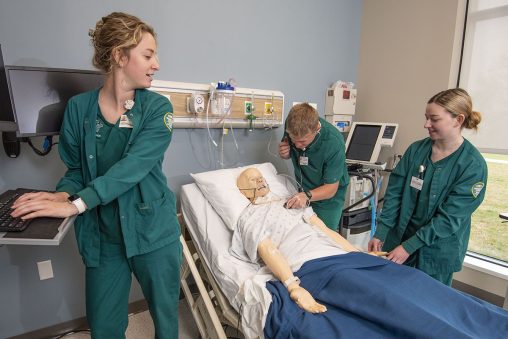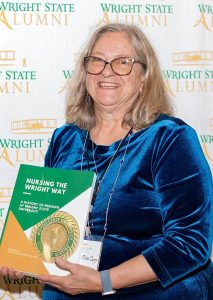
Wright State University’s nursing program prepares students to deliver excellent patient care, advocate for improved patient outcomes and help advance the nursing profession.
Wright State University’s nursing program celebrated its 50th anniversary with a special event and the release of a book outlining its history.
While much has changed since 1973 in society, the profession and at Wright State, one thing remains constant to guide nurses of the past, present and future.
“Caring is the essence of nursing,” said Donna Curry, Ph.D., professor emeritus of nursing and the nursing program’s historian. “That’s the piece we need to keep. It’s the cornerstone of nursing. Compassion to ourselves and to everyone we meet.”
Curry’s research is compiled in the book “Nursing the Wright Way: A History of Nursing at Wright State University, 1973-2023,” which was released in conjunction with the program’s golden anniversary celebration April 6 in the Student Union. The book is available on Wright State’s Core Scholar at corescholar.libraries.wright.edu/books/251.
Curry began chronicling the nursing program by collecting oral histories about 25 years ago, and for the program’s 30th anniversary, she wrote a paper that was available for use by nursing educators.
For the run-up to the golden anniversary, Curry wrote a 13-chapter book of 484 pages. The book covers the birth of nursing at Wright State and includes stories from many graduates. The closing chapters cover the changes over the last 10 years of nursing as a profession, Wright State as a whole, the pandemic and the recent reorganization of the nursing program.
Curry co-chaired the 50th anniversary celebration with Mary Murphy, retired president of Ohio’s Hospice of Dayton who earned a master’s degree in community health nursing from Wright State in 1989.
“My degree served me very well,” said Murphy, who retired four years ago after a 30-year career.
Murphy said Wright State’s nursing program is the “hallmark of nursing in this community.”
She said the program has evolved to provide lots of opportunities for nursing students.

Donna Curry, professor emeritus of nursing, released “Nursing the Wright Way: A History of Nursing at Wright State University, 1973-2023,” in conjunction with the nursing program’s 50th anniversary celebration on April 6.
“The old stereotype of a nurse solely being at a bedside is not true anymore,” she said. “There are so many other areas. There’s a tremendous diversity in jobs.”
“There’s a growing need for nurses to meet the needs of our region,” said Marty Sexton, Ph.D., professor of nursing, director of interprofessional education, and associate dean of Wright State’s College of Health, Education and Human Services.
Aside from the continuing need for bedside nurses, Sexton said there are opportunities for advanced-practice nurses, educators, leaders and researchers who are “competent, resilient and ready to navigate the challenges of our ever-evolving health care system.”
Over the nursing program’s 50-year history, 9,344 people have matriculated in some form, with about 8,700 of those earning a degree. More than 8,600 of them are still alive.
Sexton said, “I’m confident that Wright State University will continue to be a leading force in educating nurses who are prepared to deliver excellence in patient care, advocate for improved patient outcomes, and contribute to the advancement of our cherished nursing profession.”
Murphy distinguishes physicians and nurses in terms of one-to-one patient care.
“A doctor is there for five minutes. A nurse is there for 12 hours. A nurse has to be a good communicator and have a great passion for nursing,” she said.
Murphy said working in hospice she valued that “when you have an interaction with a patient and a family, you get them from a real crisis and see them through that. That has a real meaning.”
Because many nurses face issues related to stress, high workloads, short staffing and long hours in the nursing profession, Curry said nurses need to take care of themselves.
“We want to ensure a nurturing and caring environment for ourselves as well as for our patients,” she said.

 Wright State research draws attention to behavioral health’s economic impact
Wright State research draws attention to behavioral health’s economic impact  Alumni mentorship program helps new students feel welcome at Wright State
Alumni mentorship program helps new students feel welcome at Wright State  Educating future educators
Educating future educators  Student Success Center expands services to support Wright State students
Student Success Center expands services to support Wright State students  Wright State’s undergrad computer science and engineering programs ranked among top in Ohio by U.S. News
Wright State’s undergrad computer science and engineering programs ranked among top in Ohio by U.S. News 